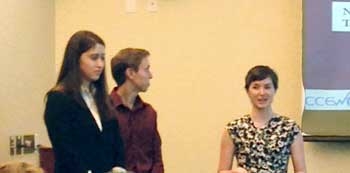Tracing tainted food back to its source
Imagine identifying the source of an outbreak from contaminated foods within hours instead of weeks. That's what several University of Oklahoma (OU) summer interns believe an innovative Lawrence Livermore National Laboratory (LLNL) technology is capable of doing.
OU students Alyssa Boutelle, Michael Petri and Lauren Gilbert evaluated a new market opportunity for an innovative Lab technology known as DNATrax - licensed to California startup DNATREK -- that was originally designed for indoor air quality applications. They are part of an OU interdisciplinary entrepreneurship program run through the university's Center for the Creation of Economic Wealth (CCEW). The students spent eight weeks at i-GATE Innovation Hub -- aregional Tri-Valley incubator that specializes in growing technology startups -- where they put together commercial opportunities for DNATrax."The CCEW Bay Area internship is about providing our best students with outstanding professional development and networking opportunities by utilizing our proven problem-solving method and commercialization expertise to further national lab technologies," said Susan Moring, a CCEW Fellow who organized the internship and advised the students.
Moring said the internship has three goals: 1) Provide recommendations that will move a lab technology closer to the market; 2) Create a pathway for talent and information flow between OU and the Bay Area technology leaders; 3) Provide a valuable real-world experience for CCEW students.
The interns recently presented their market recommendations on DNATrax to LLNL and DNATREK officials, who provided them with mentoring, business development insights and access to the Lab. i-Gate, which provided the students with guidance, and Livermore city officials also attended the presentation.
"We found that specifically within the food traceability market, the tracking of high-risk commodity foods offered the most promising market entry point for DNATrax," said Petri, who is an OU mechanical engineering grad student. "We also researched a secondary market for indoor air quality management that involves lower risk to entry."
DNATrax, which won a 2013 R&D 100 Award, is a safe and versatile material containing food-based microparticles that can be used for safe and effective detection and tracking of aerosol releases in both interior and exterior environments. The technology combines FDA-approved sugars and a unique non-biological DNA bar code to produce a microparticle that stimulates the aerosols in the air to track the source of contaminants.
Applications for the product include indoor air quality detection for homes, offices, ships and airplanes; urban particulate tracking for subways stations, train stations and convention centers; environmental release tracking; and oil and gas uses, including fracking, to better track fluid flow.
"DNATrax is an exciting technology that will help ensure the safety and quality of food, air and water resources," said Anthony Zografos, CEO of DNATREK. "The OU students did a great job in further validating the opportunities and we are excited to begin the commercialization process of the technology."
Petri and his cohorts believe that DNATrax could be applied to the food industry because of its unique DNA barcode identifier. Manufacturers can spray the material on food products at their source. If contaminated food got through the supply chain and reached consumers, the FDA or manufacturer could trace it back to the source by swabbing the food's surface and testing the samples using a polymerase chain reaction (PCR) to read the barcode. They could look up the barcode in the database and immediately know the source of the tainted food.
"This is a dramatic improvement over the standard 16 days that are required in a recall to trace back to the source," Petri said. "Because food products can be traced back more quickly, fewer people will get sick from eating contaminated products, which will result in fewer lawsuits for food processors."
In a different market, the students believe that DNATrax could be sold to indoor air quality (IAQ) professionals, who are contracted by building owners for a wide variety of tasks, ranging from increasing energy efficiency to controlling odors.
"IAQ professionals could spray DNATrax in one or several locations in a building all at once, then sample it throughout the building to determine both the presence and relative size of the leakages between rooms as well as the entire building as a whole," Petri said. "Currently, these IAQ professionals have very imprecise and expensive methods to test the airflows of large commercial buildings."
The students said they gained valuable entrepreneurial experience during their internship and work with DNATrax.
"Our team learned a great deal about the transfer of ideas and technology from lab to market and all of the challenges and opportunities that come with that transition," Boutelle said.
For more information about DNATrax, contact inventor and LLNL researcher gfarquar [at] llnl.gov (George Farquar). To learn more about opportunities at i-GATE, contact Brandon Cardwell at (925) 784-5731 or brandon.cardwell [at] igateihub.org (email).
Contact
Kenneth K Ma[email protected]
925-423-7602
Related Links
University of OklahomaCenter for the Creation of Economic Wealth
DNATrax
i-Gate
Tags
EngineeringPhysical and Life Sciences
Science
Featured Articles









